Bat Ensembles Differ in Response to Use Zones in a Tropical Biosphere Reserve
Abstract
1. Introduction
2. Materials and Methods
2.1. Study Sites
2.2. Species Capture and Identification
2.3. Acoustic Sampling and Analysis
2.4. Statistical Analysis
3. Results
3.1. Bat Assemblage
3.2. Acoustic Surveys
4. Discussion
5. Conclusions
Supplementary Materials
Author Contributions
Funding
Acknowledgments
Conflicts of Interest
References
- Giam, X. Global biodiversity loss from tropical deforestation. PNAS USA 2017, 114, 5775–5777. [Google Scholar] [CrossRef]
- Raven, P.H. Our Diminishing Tropical Forests. In Biodiversity; Wilson, E.O., Peter, F.M., Eds.; National Academies Press (US): Washington, DC, USA, 1988; pp. 119–129. [Google Scholar]
- Song, X.-P.; Hansen, M.C.; Stehman, S.V.; Potapov, P.V.; Tyukavina, A.; Vermote, E.F.; Townshend, J.R. Global land change from 1982 to 2016. Nature 2018, 560, 639–643. [Google Scholar] [CrossRef]
- Jenkins, C.N.; Joppa, L. Expansion of the global terrestrial protected area system. Biol. Conserv. 2009, 142, 2166–2174. [Google Scholar] [CrossRef]
- DeFries, R.; Hansen, A.; Turner, B.L.; Reid, R.; Liu, J. Land use change around protected areas: Management to balance human needs and ecological function. Ecol. Appl. 2007, 17, 1031–1038. [Google Scholar] [CrossRef]
- Curran, L.M.; Trigg, S.N.; McDonald, A.K.; Astiani, D.; Hardiono, Y.M.; Siregar, P.; Caniago, I.; Kasischke, E. Lowland forest loss in protected areas of Indonesian Borneo. Science 2004, 303, 1000–1003. [Google Scholar] [CrossRef]
- Terborgh, J.; Peres, C. The Problem of People in Parks. In Making Parks Work: Strategies for Preserving Tropical Nature; Terborgh, J., van Schaik, C., Davenport, L., Rao, M., Eds.; Island Press: Washington, DC, USA, 2002; pp. 307–319. [Google Scholar]
- Hill, J.L.; Curran, P.J. Area, shape and isolation of tropical forest fragments: Effects on tree species diversity and implications for conservation. J. Biogeogr. 2003, 30, 1391–1403. [Google Scholar] [CrossRef]
- Laurance, W.F.; Useche, D.C.; Rendeiro, J.; Kalka, M.; Bradshaw, C.J.A.; Sloan, S.P.; Laurance, S.G. Averting Biodiversity Collapse in Tropical Forest Protected Areas. Nature 2012, 489, 290–294. [Google Scholar] [CrossRef]
- Ishwaran, N.; Persic, A.; Nguyen, H.T. Concept and practice: The case of UNESCO biosphere reserves. IJESD 2008, 7, 118–131. [Google Scholar] [CrossRef]
- Reed, M.G. The contributions of UNESCO man and biosphere programme and biosphere reserves to the practice of sustainability science. Sustain. Sci. 2019, 14, 809–821. [Google Scholar] [CrossRef]
- UNESCO. Biosphere Reserves—Learning Sites for Sustainable Development. 2017. Available online: http://www.unesco.org/new/en/natural-sciences/environment/ecological-sciences/biosphere-reserves/ (accessed on 8 October 2019).
- UNESCO. Crocker Range. 2014. Available online: http://www.unesco.org/new/en/natural-sciences/environment/ecological-sciences/biosphere-reserves/asia-and-the-pacific/malaysia/crocker-range/ (accessed on 16 December 2019).
- UNESCO. Southeast Asian Biosphere Reserve Network. 2019. Available online: http://www.unesco.org/new/en/natural-sciences/environment/ecological-sciences/man-and-biosphere-programme/networks/seabrnet/ (accessed on 8 October 2019).
- Kunz, T.H.; de Torrez, E.B.; Bauer, D.; Lobova, T.; Fleming, T.H. Ecosystem services provided by bats. Ann. N. Y. Acad. Sci. 2011, 1223, 1–38. [Google Scholar] [CrossRef]
- Sheherazade; Ober, H.K.; Tsang, S.M. Contributions of bats to the local economy through durian pollination in Sulawesi, Indonesia. Biotropica 2019, 51, 913–922. [Google Scholar] [CrossRef]
- Fleming, T.H.; Holland, J.N. Nectar bat-plant interactions in North American deserts. Hystrix 2018, 29, 33–39. [Google Scholar]
- Jones, G.; Jacobs, D.S.; Kunz, T.H.; Willig, M.R.; Racey, P.A. Carpe noctem: The importance of bats as bioindicators. Endang. Species Res. 2009, 8, 93–115. [Google Scholar] [CrossRef]
- Voigt, C.; Kingston, T. Bats in the Anthropocene: Conservation of Bats in a Changing World; Springer International Publishing: Cham, Switzerland, 2016; p. 606. [Google Scholar]
- Frick, W.F.; Kingston, T.; Flanders, J. A review of the major threats and challenges to global bat conservation. Ann. N. Y. Acad. Sci. 2019, 1–21. [Google Scholar] [CrossRef] [PubMed]
- IUCN Red List of Threatened Species. Available online: http://www.iucnredlist.org. (accessed on 20 December 2019).
- Welch, J.N.; Beaulieu, J.M. Predicting extinction risk for data deficient bats. Diversity 2018, 10, 63. [Google Scholar] [CrossRef]
- Kingston, T.; Francis, C.M.; Zubaid, A.; Kunz, T.H. Species richness in an insectivorous bat assemblage from Malaysia. J. Trop. Ecol. 2003, 19, 67–79. [Google Scholar] [CrossRef]
- García-Morales, R.; Badano, E.I.; Moreno, C.E. Response of Neotropical bat assemblages to human land use. Conserv. Biol. 2013, 27, 1096–1106. [Google Scholar] [CrossRef]
- Meyer, C.F.J.; Struebig, M.J.; Willig, M.R. Responses of tropical bats to habitat fragmentation, logging, and deforestation. In Bats in the Anthropocene: Conservation of Bats in A Changing World; Springer International Publishing: Cham, Switzerland, 2016; pp. 63–103. [Google Scholar]
- Miettinen, J.; Shi, C.; Liew, S.C. Deforestation rates in insular Southeast Asia between 2000 and 2010. Glob. Chang. Biol. 2011, 17, 2261–2270. [Google Scholar] [CrossRef]
- Fitzherbert, E.B.; Struebig, M.; Morel, A.; Danielsen, F.; Brühl, A.C.; Donald, P.F.; Phalan, B. How will oil palm expansion affect biodiversity? Trends Ecol. Evol. 2008, 23, 538–545. [Google Scholar] [CrossRef]
- Struebig, M.J.; Bożek, J.; Hildebrand, M.; Rossiter, J.; Lane, S. Bat diversity in the lowland forests of the Heart of Borneo. Biodivers. Conserv. 2012, 21, 3711–3727. [Google Scholar] [CrossRef]
- Gaveau, D.L.A.; Kshatriya, M.; Sheil, D.; Sloan, S.; Molidena, E.; Wijaya, A.; Wich, S.; Ancrenaz, M.; Hansen, M.; Broich, M.; et al. Reconciling Forest Conservation and Logging in Indonesian Borneo. PLoS ONE 2013, 8, e69887. [Google Scholar] [CrossRef] [PubMed]
- Payne, J.; Francis, C.M.; Phillips, K.; Kartikasari, S.N. Mamalia di Kalimantan, Sabah, Sarawak dan Brunei Darussalam; Sabah Society: Kota Kinabalu, Malaysia, 1985; p. 386. [Google Scholar]
- Phillipps, Q.; Phillipps, K. Phillipps’ Field Guide to the Mammals of Borneo and Their Ecology, 2nd ed.; John Beaufoy Publishing Ltd.: Oxford, UK, 2018; p. 400. [Google Scholar]
- Lane, D.; Kingston, T.; Lee, B. Dramatic decline in bat species richness in Singapore, with implications for Southeast Asia. Biol. Conserv. 2006, 131, 584–593. [Google Scholar] [CrossRef]
- Kingston, T. Response of Bat Diversity to Forest Disturbance in Southeast Asia: Insights from Long-Term Research in Malaysia. In Bat Evolution, Ecology, and Conservation; Adams, R.A., Pedersen, S.C., Eds.; Springer New York: New York, NY, USA, 2013; pp. 169–185. ISBN 9781461473978. [Google Scholar]
- Norberg, U.M.; Rayner, J.M.V. Ecological morphology and flight in bats: Wing adaptations, flight performance, foraging strategy and echolocation. Philos. Trans. R. Soc. Lond. B Biol. Sci. 1987, 316, 335–427. [Google Scholar]
- Schnitzler, H.U.; Denzinger, A. Auditory fovea and doppler shift compensation: Adaptations for flutter detection in echolocating bats using CF-FM signals. J. Comp. Physiol. A 2011, 197, 541–599. [Google Scholar] [CrossRef]
- Schmieder, D.A.; Kingston, T.; Hashim, R.; Siemers, B.M. Sensory constraints on prey detection performance in an ensemble of vespertilionid understorey rain forest bats. Funct. Ecol. 2012, 26, 1043–1053. [Google Scholar] [CrossRef]
- Senawi, J.; Kingston, T. Clutter negotiating ability in an ensemble of forest interior bats is driven by body mass. J. Exp. Biol. 2019, 222, jeb203950. [Google Scholar] [CrossRef]
- Struebig, M.J.; Kingston, T.; Akbar, Z.; Mohd-Adnan, A.; Rossiter, S.J. Conservation value of forest fragments to Paleotropical bats. Biol. Conserv. 2008, 141, 2112–2126. [Google Scholar] [CrossRef]
- Huang, J.C.-C.; Jazdzyk, E.L.; Nusalawo, M.; Maryanto, I.; Maharadatunkamsi; Wiantoro, S.; Kingston, T. A recent bat survey reveals Bukit Barisan Selatan landscape as a chiropteran diversity hotspot in Sumatra. Acta Chiropt. 2014, 16, 413–449. [Google Scholar] [CrossRef]
- Taylor, P.J.; Sowler, S.; Schoeman, M.C.; Monadjem, A. Diversity of bats in the Soutpansberg and Blouberg Mountains of northern South Africa: Complementarity of acoustic and no-acoustic survey methods. S. Afr. J Wildl Res. 2013, 43, 12–26. [Google Scholar] [CrossRef][Green Version]
- Linden, V.M.G.; Weier, S.M.; Gaigher, I.; Kuipers, H.J.; Weterings, M.J.A.; Taylor, P.J. Changes of bat activity, species richness, diversity and community composition over an altitudinal gradient in Soutpansberg Range, South Africa. Acta Chiropt. 2014, 16, 27–40. [Google Scholar] [CrossRef]
- López-González, C.; Gómez-Ruiz, E.P.; Lozano, A.; López-Wilchis, R. Activity of insectivorous bats associated with cattle ponds at La Michilía Biosphere Reserve, Durango, Mexico: Implications for conservation. Acta Chiropt. 2015, 17, 117–129. [Google Scholar] [CrossRef]
- Weier, S.N.; Linden, V.M.G.; Gaigher, I.; White, P.J.C.; Taylor, P.J. Changes of bat species composition over altitudinal gradients on northern and southern aspects of the Soutpansberg mountain range. S. Afr. Mammal. 2017, 81, 1–12. [Google Scholar] [CrossRef]
- Yasuma, S.; Andau, M.; Apin, L.; Yu, F.T.Y.; Kimsui, L. Identification Keys to the Mammals of Borneo; Park Management Component BBEC Programme; Sabah Parks and JICA: Kota Kinabalu, Malaysia, 2003; pp. 1–85. [Google Scholar]
- Das, I. Crocker Range National Park, Sabah, as a refuge for Borneo’s montane herpetofauna. Amphib. Reptile Conserv. 2006, 4, 2–11. [Google Scholar]
- Tuen, A.A.; Rahman, M.A.; Salleh, M.A. Preliminary Survey of Mammals at Crocker Range Park, Sabah, Malaysia; ARBEC—ASEAN Review of Biodiversity and Environmental Conservation; ARBEC: Selangor, Malaysia, 2002. [Google Scholar]
- Kitayama, K. An Altitudinal Transect Study of the Vegetation on Mount Kinabalu, Borneo. Vegetatio 1992, 102, 149–171. [Google Scholar] [CrossRef]
- Weatherbase. Available online: http://www.weatherbase.com/weather/weather.php3?s=131694&cityname=Tambunan-Sabah-Malaysia&units=metric (accessed on 3 October 2019).
- Francis, C.M. A Comparison of mist nets and two types of harp traps for capturing bats. J. Mammal. 1989, 70, 865–870. [Google Scholar] [CrossRef]
- Kingston, T.; Lim, B.L.; Akbar, Z. Bats of Krau Wildlife Reserve; Universiti Kebangsaan Malaysia Publisher: Bangi, Malaysia, 2006. [Google Scholar]
- Payne, J.; Francis, C.M.; Philipps, K. A Field Guide to the Mammals of Borneo; Sabah Society and World Wildlife Fund: Kota Kinabalu, Malaysia, 1985; p. 332. [Google Scholar]
- Anthony, E.L.P. Age Determination in Bats. In Ecological and Behavioural Methods for the Study of Bats; Kunz, T.H., Ed.; Smithsonian Institute Press: Washington, DC, USA, 1988; pp. 47–58. [Google Scholar]
- Broken-Brow, J.; Thompson, D. Anabat Walkabout (Version 1.4). 2017. Available online: https://www.titley-scientific.com/uk/downloads/dl/file/id/18/product/0/anabat_walkabout_user_manual_v1_4.pdf (accessed on 1 January 2020).
- Broken-Brow, J. Anabat Insight Analysis Software (Version 1.7). 2018. Available online: https://www.titley-scientific.com/uk/downloads/dl/file/id/51/product/0/anabat_insight_user_manual_v1_7.pdf (accessed on 1 January 2020).
- R Core Team. R: A Language and Environment for Statistical Computing; R Foundation for Statistical Computing: Vienna, Austria, 2017. [Google Scholar]
- Chao, A.; Gotellie, N.J.; Hsieh, T.C.; Sander, E.L.; Ma, K.H.; Colwell, R.K.; Ellison, A.M. Rarefaction and extrapolation with Hill numbers: A framework for sampling and estimation in species diversity studies. Ecol. Monogr. 2014, 84, 45–67. [Google Scholar] [CrossRef]
- Hsieh, T.C.; Ma, K.H.; Chao, A. iNEXT: An R package for interpolation and extrapolation of speices diversity (Hill Numbers). Methods Ecol. Evol. 2016, 7, 1451–1456. [Google Scholar] [CrossRef]
- Francis, C.M.; Hill, J.E. A review of the Bornean Pipistrellus (Mammalia: Chiroptera). Mammalia 1986, 50, 43–56. [Google Scholar] [CrossRef]
- Medway, L. Mammals of Borneo. Field keys and an annotated checklist. Mon. Malay. Brch. R. Asiat. Soc. 1977, 7, 1–72. [Google Scholar]
- Wilson, D.E.; Mittermeier, R.A. (Eds.) Handbook of the Mammals of the World. Vol. 9. Bats; Lynx Edicions: Barcelona, Spain, 2013; pp. 1–1008. [Google Scholar]
- Struebig, M.J.; Christy, L.; Pio, D.; Meijaard, E. Bats of Borneo: Diversity, distributions and representation in protected areas. Biodivers. Conserv. 2010, 19, 449–469. [Google Scholar] [CrossRef]
- Kingston, T.; Jones, G.; Akbar, Z.; Kunz, T.H. Echolocation signal design in Kerivoulinae and Murininae (Chiroptera: Vespertilionidae) from Malaysia. J. Zool. Lond. 1999, 249, 359–374. [Google Scholar] [CrossRef]
- Kingston, T.; Jones, G.; Akbar, Z.; Kunz, T.H. Resource partitioning in rhinolophoid bats revisited. Oecologia 2000, 124, 332–342. [Google Scholar] [CrossRef]
- Hughes, A.C.; Satasook, C.; Bates, P.J.J.; Soisook, P.; Sritongchuay, T.; Jones, G.; Bumrungsri, S. Using echolocation calls to identify Thai bat species: Vespertilionidae, Emballonuridae, Nycteridae and Megadermatidae. Acta Chiropt. 2011, 13, 447–455. [Google Scholar] [CrossRef]
- Collen, A.L. The Evolution of Echolocation in Bats: A Comparative Approach. Ph.D. Thesis, University College London, London, UK, 2012. [Google Scholar]
- Kusuminda & Kappa. First record of a Wrinkle-lipped Free-tailed Bat Chaerephon plicatus Buchannan, 1800 (Mammalia: Chiroptera: Molossidae) colony in Sri Lanka, with notes on echolocation calls and taxonomy. J. Threat Taxa 2017, 9, 10115–10120. [Google Scholar] [CrossRef]
- Huang, J.C.-C.; Rustiati, E.L.; Nusalawo, M.; Kingston, T. Echolocation and roosting ecology determine sensitivity of forest-dependent bats to coffee agriculture. Biotropica 2019, 51, 757–768. [Google Scholar] [CrossRef]
- Wordley, C.F.R.; Sankaran, M.; Mudappa, D.; Altringham, J.D. Bats in the Ghats: Agricultural intensification reduces functional diversity and increases trait filtering in a biodiversity hotspot in India. Biol. Conserv. 2017, 210, 48–55. [Google Scholar] [CrossRef]
- Cortés-Delgado, N.; Sosa, V.J. Do bats roost and forage in shade coffee plantations? A perspective from the frugivorous bat Sturnira hondurensis. Biotropica 2014, 26, 624–632. [Google Scholar] [CrossRef]
- Struebig, M.J.; Turner, A.; Giles, E.; Lasmana, F.; Tollington, S.; Bernard, H.; Bell, D. Quantifying the biodiversity value of repeatedly logged rainforests: Gradient and comparative approaches from Borneo. Adv. Ecol. Res. 2013, 48, 183–224. [Google Scholar]
- Phommexay, P.; Satasook, C.; Bates, P.; Pearch, M.; Bumrungsri, S. The impact of rubber plantations on the diversity and activity of understorey insectivorous bats in souther Thailand. Biodivers. Conserv. 2011, 20, 1441–1456. [Google Scholar] [CrossRef]
- Meyer, C.F.J. Methodological challenges in monitoring bat population- and assemblage-level changes for anthropogenic impact assessment. Mammal. Biol. 2015, 80, 159–169. [Google Scholar] [CrossRef]
- Start, A.N. The Feeding Biology in Relation to Food Sources of Nectarivorous Bats (Chiroptera: Macroglossinae) in Malaysia. Ph.D. Thesis, University of Aberdeen, Aberdeen, Scotland, 1975. [Google Scholar]
- Wordley, C.F.R.; Sankaran, M.; Mudappa, D.; Altringham, J.D. Heard but not seen: Comparing bat assemblages and study methods in a mosaic landscape in the Western Ghats of India. Ecol. Evol. 2017, 8, 3883–3894. [Google Scholar] [CrossRef]
- Furey, N.M.; Mackie, I.J.; Racey, P.A. Bat diversity in Vietnamese limestone karst areas and the implications of forest degradation. Biodivers. Conserv. 2010, 19, 1821–1838. [Google Scholar] [CrossRef]
- Acharya, P.R.; Racey, P.A.; Sotthibandhu, S.; Bumrungsri, S. Feeding behavior of the dawn bat (Eonycteris spelaea) promotes cross pollination of economically important plants in Southeast Asia. J. Pollinat. Ecol. 2015, 15, 44–50. [Google Scholar]
- Evelyn, M.J.; Stiles, D.A. Roosting Requirements of Two Frugivorous Bats (Sturnira lilium and Artibeus intermedius) in Fragmented Neotropical Forest. Biotropica 2003, 35, 405–418. [Google Scholar] [CrossRef]
- Motoko, F.; Irham, M.; Samejima, H.; Wijamukti, S.; Haryadi, D.S.; Muhammad, A. Mammals & Birds of Bukit Batu Area of Giam Siak Kecil-Bukit Batu Biosphere Reserve, Riau, Indonesia; Kyoto Working Papers on Area Studies (G-COE Series); Center of Southeast Asia Studies: Ann Arbor, MI, USA, 2012. [Google Scholar]
- Licona, M.; McCleery, R.; Collier, B.; Brightsmith, D.J.; Lopez, R. Using ungulate occurrence to evaluate community-based conservation within a biosphere reserve model: Ungulate occurrence in Amazon. Anim. Conserv. 2011, 14, 206–214. [Google Scholar] [CrossRef]
- Woldegeorgis, G.; Wube, T. A survey on mammals of the Yayu forest in Southwest Ethiopia. Ethiop. J. Sci. 2012, 35, 135–138. [Google Scholar]
- Tabeni, S.; Spirito, F.; Ojeda, R.A. Conservation of small and medium-sized mammals following native woodland regrowth: A case study in a long-term UNESCO Biosphere Reserve, Argentina. J. Arid. Environ. 2013, 88, 250–253. [Google Scholar] [CrossRef]
- Nurul-Ain, E.; Rosli, H.; Kingston, T. Resource availability and roosting ecology shape reproductive phenology of rain forest insectivorous bats. Biotropica 2017, 49, 382–394. [Google Scholar] [CrossRef]
- Phelps, K.; Jose, R.; Labonite, M.; Kingston, T. Assemblage and species threshold responses to environmental and disturbance gradients shape bat diversity in disturbed cave landscapes. Diversity 2018, 10, 55. [Google Scholar] [CrossRef]
- Boyles, J.G.; Storm, J.J. The perils of picky eating: Dietary breadth is related to extinction risk in insectivorous bats. PLoS ONE 2007, 2, e672. [Google Scholar] [CrossRef] [PubMed]
- Ewers, R.M.; Boyle, M.J.W.; Gleave, R.A.; Plowman, N.S.; Benedick, S.; Bernard, H.; Bishop, T.R.; Bakhtiar, E.Y.; Chey, V.K.; Chung, A.Y.C.; et al. Logging cuts the functional importance of invertebrates in tropical rainforest. Nat. Commun. 2015, 6, 6836. [Google Scholar] [CrossRef]
- Fukuda, D.; Tisen, O.B.; Momose, K.; Sakai, S. Bat diversity in the vegetation mosaic around a lowland dipterocarp forest of Borneo. Raffles B. Zool. 2009, 57, 213–221. [Google Scholar]
- Cisneros, L.M.; Burgio, K.R.; Dreiss, L.M.; Klingbeil, B.T.; Patterson, B.D.; Presley, S.J.; Willig, M.R. Multiple dimensions of bat biodiversity along an extensive tropical elevational gradient. J. Anim. Ecol. 2014, 83, 1124–1136. [Google Scholar] [CrossRef]
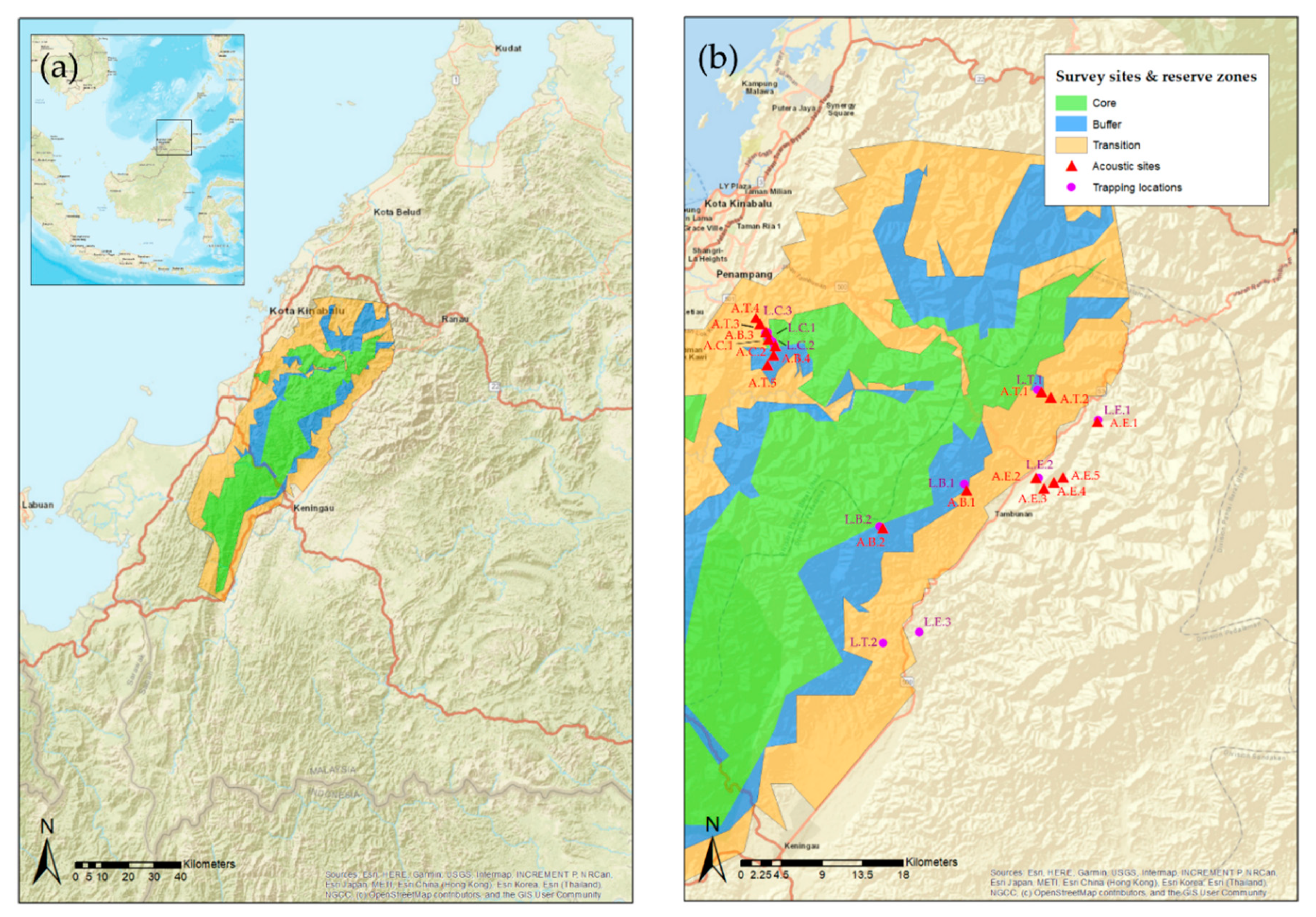
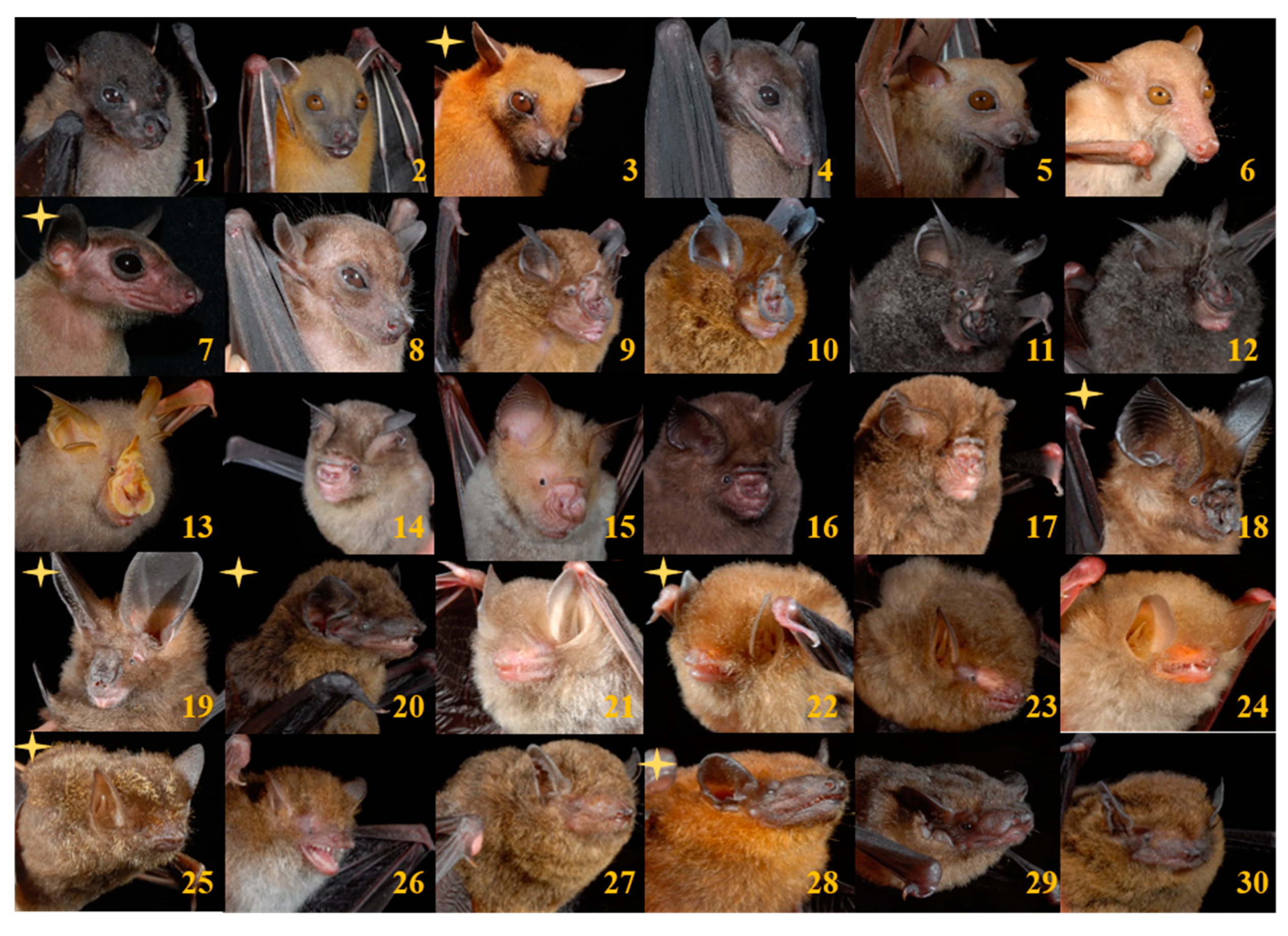
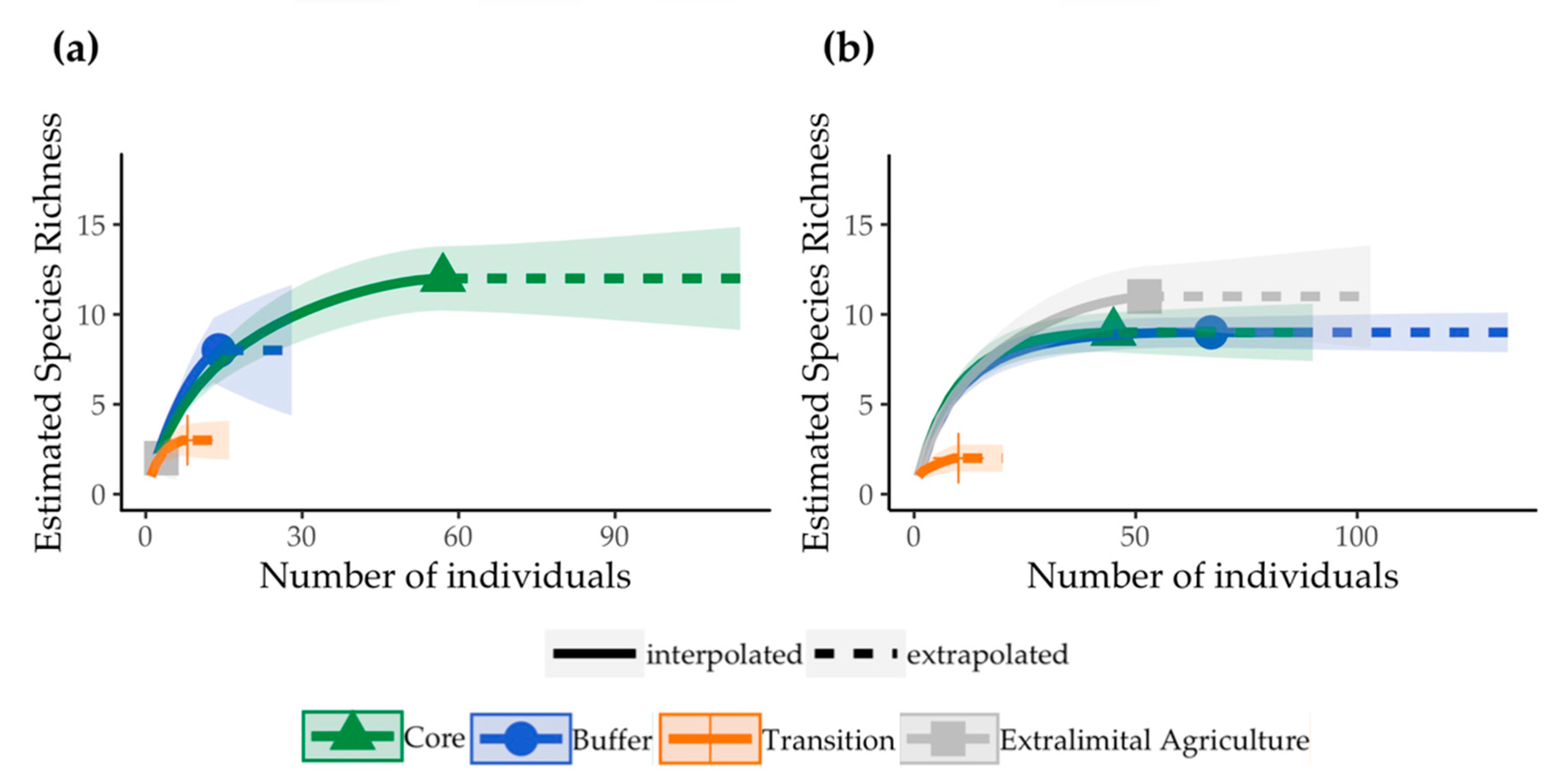
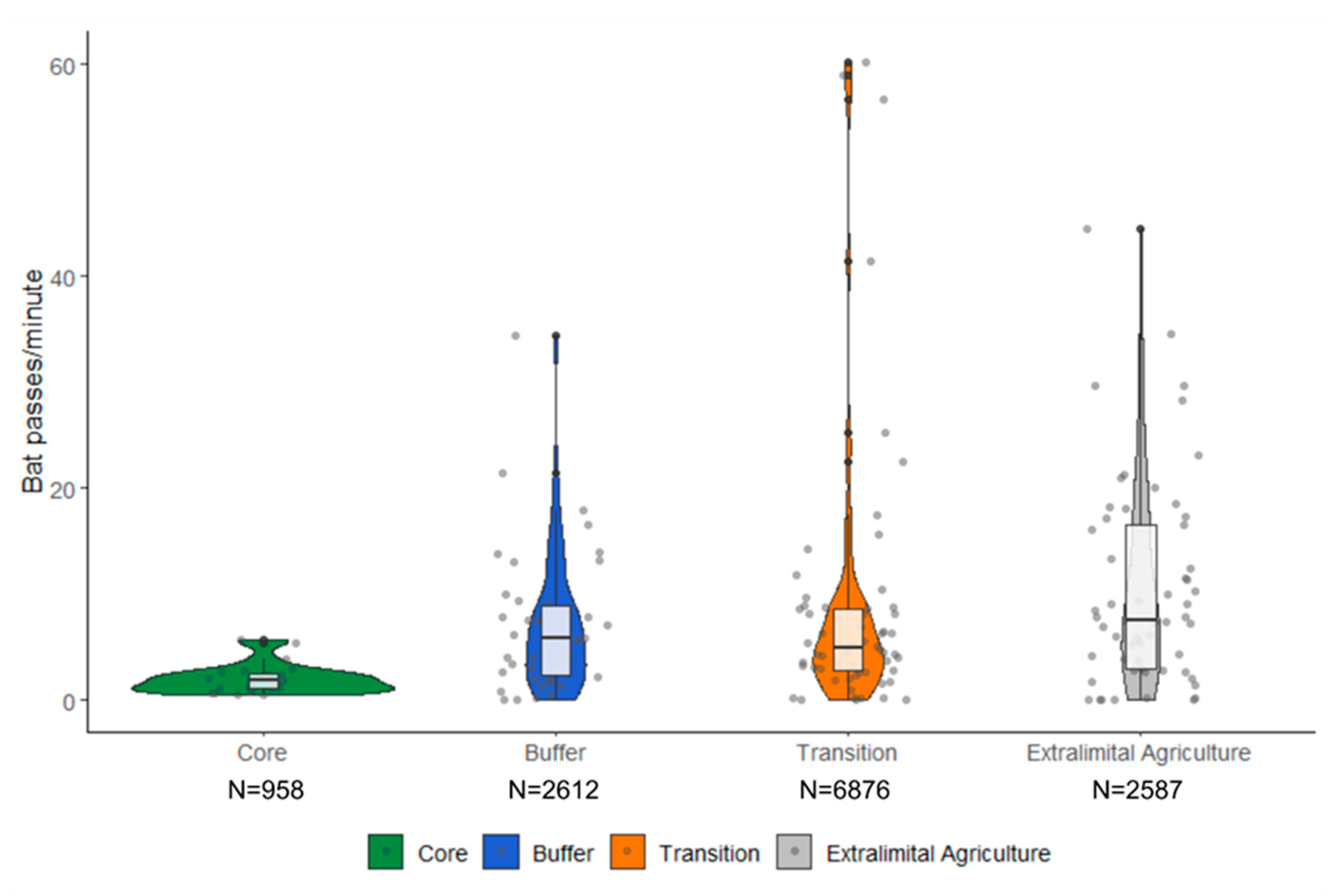
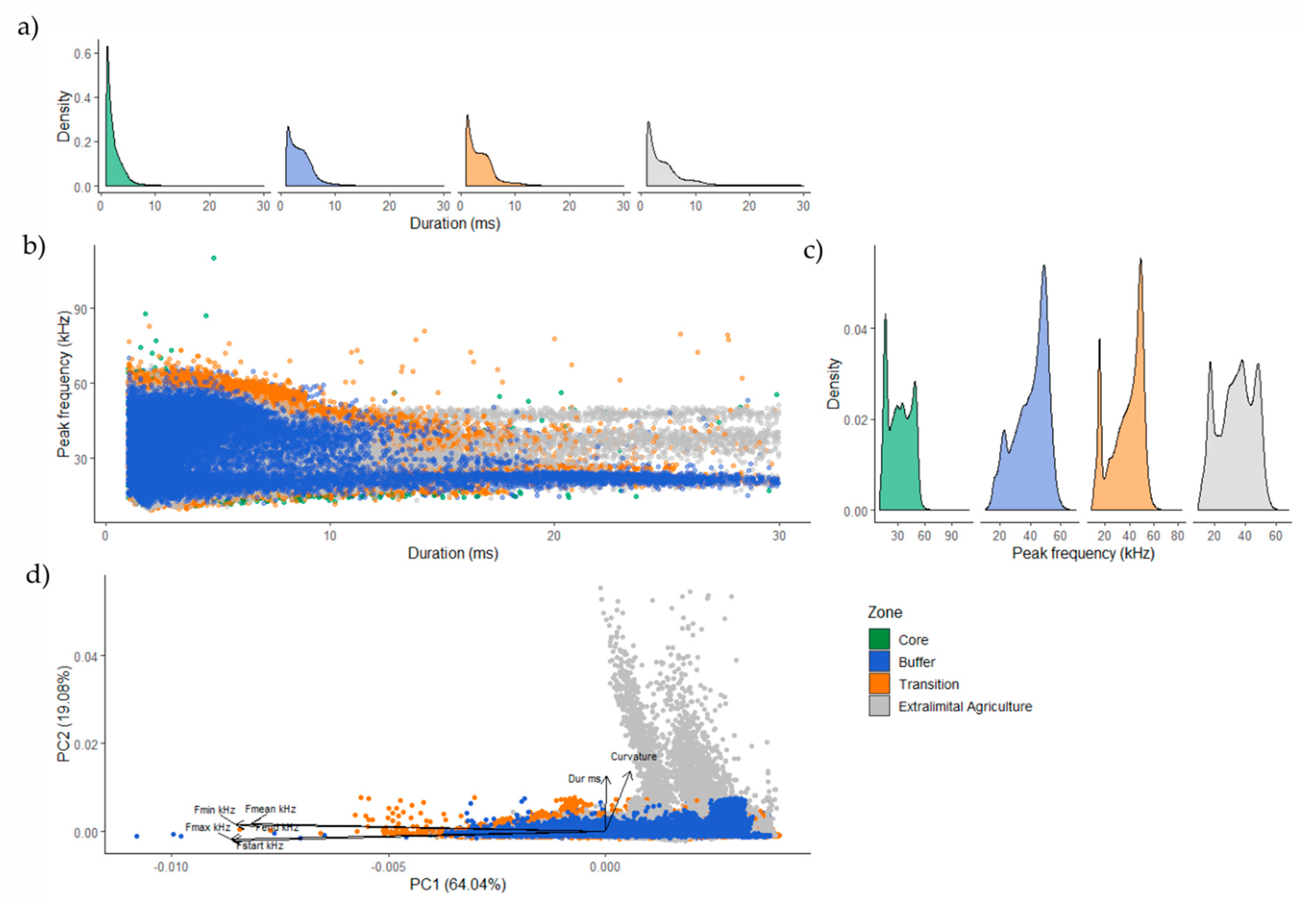
| Taxa | FE | Core | Buffer | Transition | Extralimital | Grand Total | ||||||||||||
|---|---|---|---|---|---|---|---|---|---|---|---|---|---|---|---|---|---|---|
| HT | MN/SN | Total Captures | HT | MN/SN | Total Captures | HT | MN/SN | Total Captures | HT | MN/SN | Total Captures | Captures | ||||||
| Effort (Hours) | 699 | 1569 | 248 | 1307 | 100 | 258 | 332 | 1291 | ||||||||||
| Pteropodidae | ||||||||||||||||||
| Balionycteris maculata | P | 1 | 3 | 4 | 2 | 2 | 0 | 3 | 3 | 9 | ||||||||
| Cynopterus brachyotis | P | 10 | 10 | 8 | 8 | 7 | 7 | 3 | 3 | 28 | ||||||||
| * Cynopterus minutus | P | 7 | 7 | 0 | 0 | 5 | 5 | 12 | ||||||||||
| Eonycteris major | P | 0 | 1 | 1 | 0 | 2 | 2 | 3 | ||||||||||
| Megaerops ecuadatus | P | 2 | 2 | 4 | 0 | 0 | 0 | 4 | ||||||||||
| Macroglossus minimus | P | 1 | 1 | 2 | 8 | 8 | 0 | 29 | 29 | 39 | ||||||||
| Penthetor lucasi | P | 0 | 1 | 1 | 0 | 1 | 1 | 2 | ||||||||||
| * Rousettus amplexicaudatus | P | 0 | 0 | 0 | 1 | 1 | 1 | |||||||||||
| Hipposideridae | ||||||||||||||||||
| Coelops robinsoni | F | X | 0 | 0 | ||||||||||||||
| Hipposideros cervinus | F | 9 | 9 | 0 | 0 | 0 | 9 | |||||||||||
| Hipposideros diadema | F/E | 0 | 1 | 1 | 0 | 1 | ||||||||||||
| Hipposideros dyacorum | F | 1 | 1 | 0 | 0 | 0 | 1 | |||||||||||
| Hipposideros galeritus | F | 0 | 1 | 1 | 0 | 0 | 1 | |||||||||||
| * Hipposideros ridleyi | F | 0 | 2 | 2 | 0 | 0 | 2 | |||||||||||
| Rhinolophidae | ||||||||||||||||||
| Rhinolophus acuminatus | F | 0 | 0 | 1 | 1 | 0 | 1 | |||||||||||
| Rhinolophus borneensis | F | 0 | 0 | 4 | 4 | 0 | 4 | |||||||||||
| Rhinolophus luctus | F/E | 0 | 0 | 0 | 1 | 1 | 1 | |||||||||||
| Rhinolophus sedulus | F | 1 | 1 | 1 | 1 | 0 | 1 | 1 | 3 | |||||||||
| Rhinolophus trifoliatus | F | 9 | 1 | 10 | 1 | 1 | 0 | 1 | 1 | 12 | ||||||||
| Vespertilionidae | ||||||||||||||||||
| Glischropus tylopus | E | 6 | 3 | 11 ** | 24 | 24 | 3 | 3 | 4 | 4 | 42 | |||||||
| * Hypsugo cf kitcheneri | E | 0 | 0 | 1 ** | 0 | 1 | ||||||||||||
| * Kerivoula intermedia | F | 0 | 4 | 4 | 0 | 0 | 0 | |||||||||||
| Kerivoula papillosa | F | 0 | 1 | 1 | 3 | 3 | 0 | 4 | ||||||||||
| Kerivoula pellucida | F | 0 | 0 | 0 | 1 | 1 | 1 | |||||||||||
| Kerivoula hardwickii | F | 15 | 15 | 1 | 1 | 0 | 2 | 2 | 18 | |||||||||
| Murina suilla | F | 0 | 1 | 1 | 0 | 0 | 1 | |||||||||||
| Pipistrellus javanicus | E | 0 | 1 | 1 | 0 | 0 | 1 | |||||||||||
| * Phoniscus atrox | F | 1 | 1 | 0 | 0 | 0 | 1 | |||||||||||
| * Tylonycteris pachypus | E | 6 | 6 | 2 | 2 | 0 | 0 | 8 | ||||||||||
| Tylonycteris robustula | E | 10 | 10 | 20 | 2 | 23 | 25 | 0 | 0 | 45 | ||||||||
| Nycteridae | ||||||||||||||||||
| * Nycteris tragata | F | 1 | 1 | 0 | 0 | 0 | 1 | |||||||||||
| Total Captures | 59 | 43 | 102 | 14 | 67 | 85 | 9 | 3 | 19 | 3 | 51 | 54 | 260 | |||||
| Species Richness | 12 | 9 | 16 | 9 | 9 | 18 | 3 | 2 | 6 | 2 | 11 | 13 | 31 | |||||
| Taxa | Measurements | ||||
|---|---|---|---|---|---|
| Mean ± SD Min–Max (n) | |||||
| Forearm Length (mm) | Body Mass (g) | ||||
| M | F | M | F | ||
| Pteropodidae | |||||
| Balionycteris maculata | 41.59 ± 2.28 36.9–44.6 (9) | 14.89 ± 3.16 9.25–19 (9) | |||
| Cynopterus brachyotis | 58.79 ± 3.14 54.3–66.1 (12) | 59.07 ± 2.49 53.6–64.7 (15) | 28.93 ± 4.36 20–38.1 (13) | 31.67 ± 5.92 25–44 (15) | |
| Cynopterus minutus | 57.35 ± 0.56 56.7–58.1 (6) | 56.73 ± 1.34 54. 1–57.7 | 24.33 ± 2.07 22–28 | 29.33 ± 6.35 19–37 (6) | |
| Eonycteris major | 84.8 ± 3.25 82.5–87.1 (2) | 76.5 (1) | 120 (1) | 77 (1) | |
| Megaerops ecuadatus | 53.4 (1) | 52.23 ± 1.05 51.2–53.3 (3) | 23 (1) | 25.33 ± 4.16 22–30 (3) | |
| Macroglossus minimus | 40.51 ± 1.63 37.9–44.3 (15) | 40.56 ± 1.36 38.1–43.7 (20) | 16.99 ± 2.99 10–20.5 (15) | 17.49 ± 3.31 12.25–24 (19) | |
| Penthetor lucasi | 60.2 (1) | 60.5 (1) | 36 (1) | 42 (1) | |
| Rousettus amplexicaudatus | 68.4 (1) | 44 (1) | |||
| Hipposideridae | |||||
| Hipposideros cervinus | 50.1 ± 1.05 49.1–51.2 (3) | 51.93 ± 1.19 50–53.7 (6) | 10.5 ± 0.87 10–11.5 (3) | 11.16 ± 1.21 9.5–12.5 (6) | |
| Hipposideros diadema | 88.7 (1) | 51 (1) | |||
| Hipposideros dyacorum | 42.3 (1) | 7 (1) | |||
| Hipposideros galeritus | 49.7 (1) | 9.5 (1) | 49.7 (1) | ||
| Hipposideros ridleyi | 49.2 (1) | 48 (1) | 8.25 (1) | 9.25 (1) | |
| Rhinolophidae | |||||
| Rhinolophus acuminatus | 49.4 (1) | 14.25 (1) | |||
| Rhinolophus borneensis | 40.25 ± 0.07 40.2–40.3 (2) | 43.95 ± 0.5 43.6–44.3 (2) | 9.5 (2) | 8.88 ± 0.53 8.5–9.25 (2) | |
| Rhinolophus luctus | 64 (1) | 29 (1) | |||
| Rhinolophus sedulus | 46.97 ± 6.7 42.1–54.6 (3) | 14.33 ± 5.77 11–21 (3) | |||
| Rhinolophus trifoliatus | 52.61 ± 2.3 48.7–54.9 (7) | 53.16 ± 1.87 49.9–54.6 (5) | 14.61 ± 1.98 12.5–17.25 (5) | 16.65 ± 1.90 14.25–19 (7) | |
| Nycteridae | |||||
| Nycteris tragata | 51.6 (1) | 17.5 (1) | |||
| Vespertilionidae | |||||
| Glischropus tylopus | 30.44 ± 0.84 28.7–31.9 (20) | 30.70 ± 2.2 22.2–33.3 (22) | 4.44 ± 0.43 3–5 (20) | 4.46 ± 0.72 3.4–6.5 (22) | |
| Hypsugo cf. kitcheneri | 35 (1) | 5.75 (1) | 35 (1) | ||
| Kerivoula intermedia | 28.75 ± 0.31 28.4–29.1 (4) | 2.88 ± 0.14 2.75–3 (4) | 28.75 ± 0.31 28.4–29.1 (4) | ||
| Kerivoula papillosa | 38.4 ± 8.1 29.1–43.9 (3) | 37.1 (1) | 8.75 ± 3.46 4.75–10.75 (3) | 6 (1) | |
| Kerivoula pellucida | 31.1 (1) | 5.5 (1) | |||
| Kerivoula hardwickii | 31.95 ± 1.09 30.1–33.5 (13) | 33.12 ± 1.183 1.5–34.8 (5) | 3.56 ± 0.41 2.5–4 (12) | 4.65 ± 0.34 4.25–5 (5) | |
| Murina suilla | 31.4 (1) | 4.75 (1) | |||
| Pipistrellus javanicus | 34.3 (1) | 6 (1) | |||
| Phoniscus atrox | 33.9 (1) | 4.5 (1) | |||
| Tylonycteris pachypus | 25.36 ± 0.98 24.3–26.4 (5) | 25.63 ± 0.97 24.8–26.7 (3) | 3.35 ± 0.42 2.75–3.7 (5) | 3.33 ± 0.58 3–4 (3) | |
| Tylonycteris robustula | 28.96 ± 2.41 25.4–38.6 (22) | 28.19 ± 3.15 18.3–38.3 (23) | 7.39 ± 1.24 4.25–10 (22) | 6.80 ± 1.0 4–9.5 (23) | |
© 2020 by the authors. Licensee MDPI, Basel, Switzerland. This article is an open access article distributed under the terms and conditions of the Creative Commons Attribution (CC BY) license (http://creativecommons.org/licenses/by/4.0/).
Share and Cite
Yoh, N.; Azhar, I.; Fitzgerald, K.V.; Yu, R.; Smith-Butler, T.; Mahyudin, A.; Kingston, T. Bat Ensembles Differ in Response to Use Zones in a Tropical Biosphere Reserve. Diversity 2020, 12, 60. https://doi.org/10.3390/d12020060
Yoh N, Azhar I, Fitzgerald KV, Yu R, Smith-Butler T, Mahyudin A, Kingston T. Bat Ensembles Differ in Response to Use Zones in a Tropical Biosphere Reserve. Diversity. 2020; 12(2):60. https://doi.org/10.3390/d12020060
Chicago/Turabian StyleYoh, Natalie, Isham Azhar, Katheryn V. Fitzgerald, Rieka Yu, Tenaja Smith-Butler, Azniza Mahyudin, and Tigga Kingston. 2020. "Bat Ensembles Differ in Response to Use Zones in a Tropical Biosphere Reserve" Diversity 12, no. 2: 60. https://doi.org/10.3390/d12020060
APA StyleYoh, N., Azhar, I., Fitzgerald, K. V., Yu, R., Smith-Butler, T., Mahyudin, A., & Kingston, T. (2020). Bat Ensembles Differ in Response to Use Zones in a Tropical Biosphere Reserve. Diversity, 12(2), 60. https://doi.org/10.3390/d12020060





